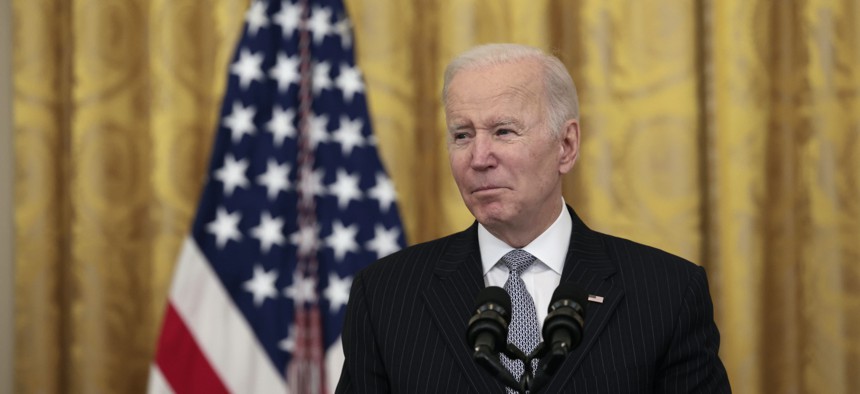
Getty Images / Anna Moneymaker
ISIS Leader Dead After US Raid in Syria, Biden Says
A U.S. helicopter malfunctioned and was intentionally destroyed during the mission, officials say.
Updated 11:02 a.m. ET
The leader of ISIS, Abu Ibrahim al-Hashimi al-Qurayshi, killed himself and members of his family during a U.S. raid that targeted him in northwestern Syria, President Joe Biden announced Thursday morning.
“This operation is testament to America’s reach and capabilities to take out terrorist threats no matter where they try to hide anywhere in the world,” Biden said from the White House. “Last night’s operation took a major terrorist leader off the battlefield and it sent a strong message to terrorists around the world that we will come after you and find you.”
The president ordered the Pentagon on Tuesday to proceed with the strike, which officials first briefed to him over a month ago, a senior administration official said. Biden tracked the operation Wednesday night from the White House Situation Room, the official added.
Biden ordered troops to conduct a ground operation instead of an air strike to protect civilians living in the same residential building as al-Qurayshi who did not have any affiliation with ISIS, the senior administration official told reporters.
U.S. forces entered the building after midnight on Feb. 3 local time, the official said. They evacuated one man, one woman, and multiple children from the first floor early in the operation. American officials did not know who lived on the building’s third floor. Troops also alerted local residents that an operation was underway as the raid began to ensure they did not unintentionally interfere.
When military forces confronted al-Qurayshi on the second floor of the building, he detonated an explosion that killed his wife and children, Biden said. The blast destroyed much of the third floor and threw bodies from the building, the senior administration official said.
“All casualties at the site were due to acts of ISIS terrorists,” the official said.
Because past ISIS targets also detonated large explosions when confronted, American operators were “well outside” the expected range of any blast, a second official said. In October 2019, for example, Abu Bakr al-Baghdadi, the former emir of ISIS, also detoned a suicide vet when he was cornered by American troops.
No American troops were killed or injured in the raid, Biden said.
Near the end of the two-hour operation, local forces fired at an American helicopter, the second administration official said. U.S. troops returned fire, killing at least two enemy combatants. That area of Syria is controlled by Hay’at Tahrir al-Sham, a terrorist group that is affiliated with Al Qaeda, the second official said.
Unrelated to that attack, an American helicopter had a mechanical issue, and was properly destroyed away from the operation site, the second official said.
Al-Qurayshi was appointed ISIS leader more than two years ago, following the death of Abu Bakr al-Baghdadi in a U.S. military raid back in 2019. He was known as a politically saavy religious scholar, the Combating Terrorism Center at West Point wrote in a report on him from September 2020. According to ISIS messaging at the time, al-Baghdadi handpicked al-Quarayshi as his successor, Thomas Jocelyn reported at the Foundation for Defense of Democracies in November 2019. Just days after he assumed the role, other jihadis in the region derided him as a “secluded paper caliph” and “an unknown nobody,” according to CTC.
CTC also says al-Qurayshi was interrogated by U.S. forces in Iraq back in 2008, when he was known as Amir Muhammad Sa’id ‘Abd-al-Rahman al-Mawla. A person with that name was designated a global terrorist by the U.S. State Department in March 2020. According to the State Department, “Al-Mawla was active in ISIS’s predecessor organization, al-Qai’da in Iraq, and steadily rose through the ranks of ISIS to become the Deputy Amir. Al-Mawla helped drive and attempt to justify the abduction, slaughter, and trafficking of Yazidi religious minorities in northwest Iraq and oversees the group’s global operations.”
The route leading to al-Qurayshi’s last location was known by U.S. military intelligence analysts for at least several months. “ISIS leaders depend on known routes that traverse ungoverned areas of the Syrian desert to connect from Idlib governorate to Iraq’s Anbar desert,” the Defense Intelligence Agency wrote in a report over the summer on ISIS.
Jen Hlad and Ben Watson contributed to this report.




